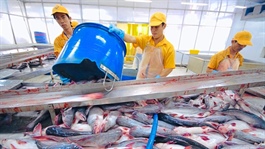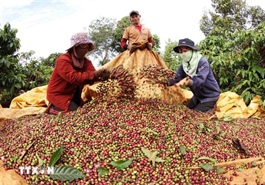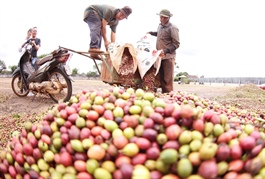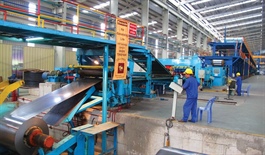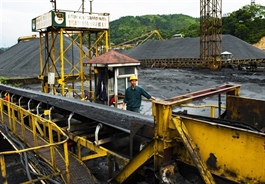Steel producers face debt, market pressures
Steel producers face debt, market pressures
While some firms are restructuring or focusing on the domestic market, a strategy that appears to be yielding positive results, others are still caught in a cycle of losses and financial distress.
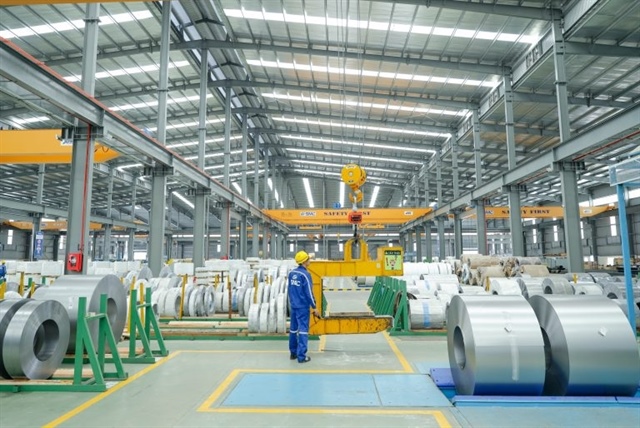
A warehouse of SMC Trading Investment. — Photo smc.vn |
The Vietnamese steel industry continues to navigate a volatile landscape in 2025, with companies facing a stark divide between those weathering the storm and those struggling under mounting debts. Despite a slight recovery in domestic demand, many firms are grappling with slow sales and financial strain.
The financial performance of steel companies shows pronounced divergence. While some firms are restructuring or focusing on the domestic market—a strategy that appears to yield positive results—others remain trapped in a cycle of losses and financial distress.
For instance, SMC Trading Investment JSC reported a 20.4 per cent decline in revenue in the first three quarters of 2025, totalling VNĐ5.37 trillion (US$204 million), with a net loss of VNĐ158.87 billion compared with a profit of VNĐ6.8 billion in the same period last year.
The company's gross profit margin has turned negative, compounded by high financial and sales costs, pushing SMC back into the red after a brief respite in 2024. Following a challenging period of heavy losses in 2022-23, SMC managed to break even last year largely by liquidating high-liquidity assets, including divesting from Nam Kim Steel Corporation.
However, the situation has deteriorated again in 2025, with accumulated losses reaching VNĐ318.08 billion by the end of September, accounting for more than 43 per cent of its charter capital. Notably, SMC is relying on over VNĐ1 trillion in short-term capital to finance long-term assets while shouldering a staggering VNĐ2.29 trillion in debt, 352.4 per cent of its equity.
Similarly, Pomina Steel Corporation faces dire circumstances. Although its revenue rose by 7.5 per cent year-on-year, reaching VNĐ1.69 trillion in the first nine months, the company recorded a significant net loss of VNĐ512.4 billion due to soaring financial costs. By September 30, Pomina's cumulative losses reached VNĐ3.05 trillion, exceeding its charter capital of VNĐ2.8 trillion and resulting in negative equity of VNĐ186.9 billion. With only about VNĐ22.37 billion in cash and debts nearing VNĐ5.95 trillion, Pomina is also using over VNĐ6.77 trillion in short-term funds to cover long-term assets, creating a precarious financial structure.
Reorganisation and investment challenges
Both SMC and Pomina are caught in a complex web of restructuring and capital management dilemmas. The lack of financial resources hampers their recovery processes, particularly amid uncertain market conditions. Maintaining liquidity and managing substantial debts are urgent challenges these companies must address.
In contrast, firms in the galvanised steel segment are showing greater adaptability by shifting strategies towards the domestic market and reducing reliance on exports. For example, Hoa Sen Group reported a 7 per cent revenue decline to VNĐ36.54 trillion for the 2024-25 financial year, but net profits surged by 42.1 per cent to VNĐ731.5 billion, aided by improved gross profit margins. This success can be attributed to effective cash flow management, with the company decreasing inventory and receivables while reducing short-term debt.
Nam Kim Steel is also changing its approach. Although its revenue decreased by 27.7 per cent to VNĐ11.67 trillion in the first nine months, leading to a 52.5 per cent drop in net profit, Nam Kim is focusing on strengthening its domestic position. The proportion of domestic sales has risen from 32.2 per cent to 57.6 per cent, compensating for the drop in exports from 67.8 per cent to 42.4 per cent.
Despite ongoing challenges, the steel sector is poised to benefit from renewed public investment and an uptick in the real estate market. A recovery in domestic demand could allow firms like Hoa Sen and Nam Kim to stabilise production and pricing. Nevertheless, companies with weak financial foundations still face substantial hurdles to their survival.
- 11:26 20/11/2025




